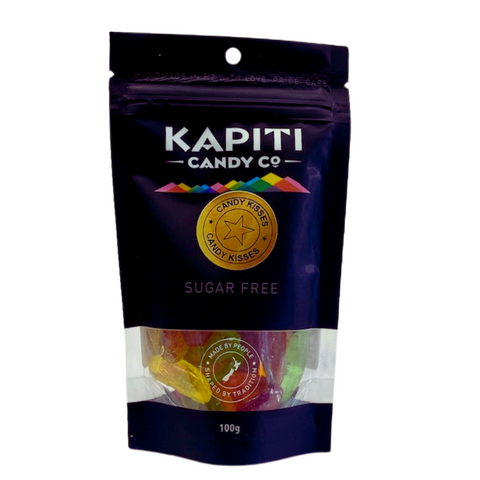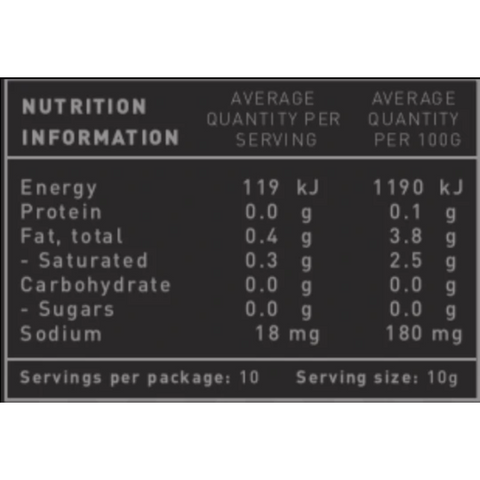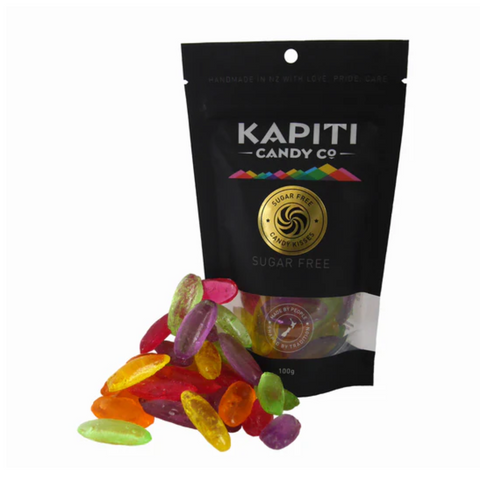


Kapiti Candy Co
CANDY KISSES Sugar Free Candy Kisses 100g
.Indulge in the guilt-free pleasure of Sugar Free Candy Kisses! These delicious candies offer sweet flavors without the added sugar, perfect for those with a sweet tooth but watching their sugar intake. Made on the beautiful Kapiti Coast of New Zealand, you can taste the quality and care in every bite.
INGREDIENTS: Isomalt (953), Acesulphame Potassium (950), Colour (102, 110, 123 & 133), Flavours
100g bag.
MAY HAVE A LAXATIVE EFFECT.
MAY CONTAIN GLUTEN, PEANUTS, MILK, SOY, ALMONDS, CASHEWS, BRAZIL NUTS, WALNUTS, HAZELNUTS, PECANS, MACADAMIA NUTS, PISTACHIOS.
What is E 953 Isomalt?
E 953 Isomalt is a sugar substitute that is commonly used in the food industry. It is a type of sugar alcohol that is derived from sugar beets. Isomalt is a versatile ingredient that can be used in a variety of food products, including candies, chocolates, baked goods, and beverages. It is known for its sweet taste and low calorie content, making it an attractive option for those who are looking to reduce their sugar intake.
Benefits of E 953 Isomalt
Isomalt offers several benefits when it comes to nutrition. Firstly, it has a lower calorie content compared to regular sugar. This makes it a suitable option for individuals who are following a calorie-restricted diet or trying to lose weight. Additionally, isomalt has a lower glycemic index, which means it has a smaller impact on blood sugar levels. This makes it a suitable choice for individuals with diabetes or those who are trying to manage their blood sugar levels.
Uses of E 953 Isomalt
E 953 Isomalt is commonly used in the food industry as a sugar substitute. It can be found in a wide range of products, including sugar-free candies, chocolates, chewing gum, and baked goods. Isomalt is also used as a bulking agent, meaning it can add volume and texture to food products without adding extra calories. This makes it a popular ingredient in low-calorie and sugar-free desserts.
Is E 953 Isomalt Safe?
Isomalt is considered safe for consumption by regulatory authorities, including the Food and Drug Administration (FDA) and the European Food Safety Authority (EFSA). It has been extensively studied and has been found to have no adverse effects on human health when consumed in moderate amounts. However, like any other sugar substitute, isomalt may cause digestive issues such as bloating, gas, and diarrhea in some individuals when consumed in large quantities.
Conclusion
E 953 Isomalt is a sugar substitute that offers several benefits when it comes to nutrition. It is a low-calorie alternative to regular sugar and has a lower glycemic index, making it suitable for individuals who are watching their calorie intake or managing their blood sugar levels. Isomalt is commonly used in a variety of food products and is considered safe for consumption when consumed in moderation. However, it is important to note that excessive consumption of isomalt may cause digestive issues in some individuals. Overall, isomalt can be a useful ingredient for those looking to reduce their sugar intake or follow a healthier diet.
WHAT IS Acesulphame Potassium (950)
Acesulfame potassium, 200 times sweeter than sugar, is an artificial sweetener used in food and beverage to replace sugar by providing a sweet taste with no calories and zero glycemic index, which may be helpful in controlling weight & obesity and benefit to diabetes. The European food additive number is E950. You might also see this ingredient listed as Ace-K or Acesulfame K in the food label.
Ace-K is one of eight approved high intensity sweeteners in the United States by the FDA. The other seven are saccharin (E954), aspartame (E951), sucralose (E955), neotame (E961), advantame (E969), steviol glycosides (E960) and luo han guo fruit extracts.
How is it made?
Ace-K is commercially made from the chemical reactions among sulfamic acid, diketene, triethylamine, acetic acid, sulfur trioxide and potassium hydroxide.
The following is the 5 steps brief manufacturing processes (1):
- Step 1: the reaction among sulfamic acid, triethylamine and acetic acid to synthesize amidosulfamic acid salt.
- Step 2: acetoacetamide salt formed by reacting amidosulfamic acid salt with diketene.
- Step 3: reacting the acetoacetamide salt with a cyclizing agent sulfur trioxide to form a cyclic sulfur trioxide adduct.

- Step 4: obtaining acesulfame -H by hydrolyzing the cyclic sulfur trioxide adduct.
- Step 5: neutralizing acesulfame-H with potassium hydroxide to obtain the final product.
What are the health benefits?
Ace-k is quickly excreted via the urine unchanged after absorption and no accumulation in our body. It contributes zero calorie, without raising insulin levels, and does not promote dental caries.
Is acesulfame potassium safe?
Yes, the safety used as a food additive has been approved by the U.S. Food and Drug Administration (FDA), European Food Safety Authority (EFSA), Joint FAO/WHO Expert Committee on Food Additives (JECFA), as well as other authorities.
Zero Glycemic Index
Acesulfame k cannot be metabolized in the human body so it has a glycemic index with 0. That’s to say, it does not raise blood sugar and insulin levels and therefore it is safe for diabetics.
Tooth friendly
It will not cause tooth decay so it is a suitable ingredient to be added in food for children.


